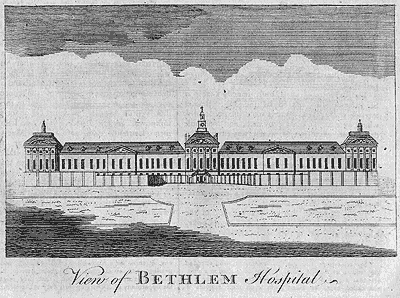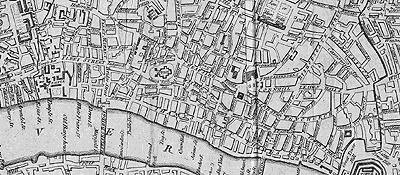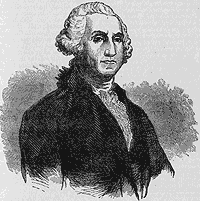|

NOTES ON ISSUE 3: GLOSSARY
PART 4 OF 4
For, people then paid to see the play at
the Old Bailey, just as they paid to see the play in Bedlam…
Bethlehem Hospital of London, popularly called “Bedlam,”
is identified by Baedeker’s London and Its Environs
(1908) as “the oldest charitable institution for the insane
in the world” (381). During the period in which A
Tale of Two Cities is set, Bedlam was located in Moorfields
(in north-eastern London); its earlier location, in Bishopsgate
Street, had been pulled down in 1675. However, by the time Dickens
was writing the novel, Bedlam – though still an insane
asylum, and still a landmark in London – had moved again
(in 1812), this time to St. George’s Fields, Lambeth (Baedeker
381). The Bedlam in A Tale of Two Cities is thus the
second Bedlam – the one standing in Moorfields from 1675-1812.
Until 1770, Bedlam was open to the public,
who could tour galleries of the insane for a penny. The hospital
realized about £400 a year through this means (Sanders
62), but – as is noted in the passage below – the
practice of making a spectacle of the mentally ill was cruel
and medically detrimental, and was ultimately discontinued.
However, it is this possibility of touring Bedlam that Dickens
refers to as “[paying] to see the play in Bedlam.”
By 1780 – the year in which this portion of the novel
takes place – admission was granted to outsiders only
by special permission of one of the governors of the asylum.
Harrison’s New and Universal History, Description
and Survey of … London (1776) gives an account and
illustration of the building as it appeared at the time:
BETHLEHEM
HOSPITAL.
This hospital … was founded for lunatics, near the north-east
corner of the Lower Moorfields, in Bishopsgate parish; but
that becoming ruinous, as well as too small to answer the
purposes of the charity, the lord-mayor, aldermen and common-council
granted the governors the spot of ground whereon the present
edifice stands, the foundation of which was laid in the month
of April 1675: but the wings on each side were not erected
till some years after the building was completed.
This magnificent structure is 540 feet in length, and 40 feet
in breadth. The middle and ends, which project a little, are
adorned with pilasters, entablatures, foliages, &c. and,
rising above the rest of the building, have each a flat roof,
with a handsome balustrade of stone, in the center of which
is a handsome turret. That in the middle is adorned with a
clock and three dials, on the top of which is a gilt ball
and fane. The whole is built of brick and stone, and [e]nclosed
by a handsome wall, formed of the same materials, 680 feet
long. In the center of this wall, which goes in with a grand
semicircular sweep, is a large pair of fine iron gates, supported
by stone piers, on the top of which are two images, or statues,
in a reclining posture; one representing Raving, and the other
Melancholy, Madness. These figures are finely expressed, and
were executed by Mr. Cibber…. This wall encloses a range
of gardens neatly adorned with walks of broad stone, grass-plats
and trees. In the east division, which is separated by the
entrance into the hospital, those of the lunaticks, who are
well enough to be suffered to go about, are allowed to walk
there, and enjoy the benefit of the fresh air.
The inside of this building chiefly consists of two galleries,
one over the other, which are 193 yards long, 13 feet high,
and 16 feet broad, exclusive of the cells. These galleries
are divided in the middle by two iron gates, in order to separate
the men from the women; the latter being confined to the western
part, and the former to the eastern part of the hospital.
At the entrance between these two gates, on the right hand,
is [a] handsome apartment for the steward, who is the manager,
under the direction of the committee. On the left is a spacious
room, in which the committee sit to receive and discharge
patients. Below stairs is a good kitchen, and all necessary
offices for keeping and dressing provisions, washing, &c.
and at the south-east corner is a bath for the use of the
patients.
There are about two hundred cells, or rooms for patients,
which are furnished with beds, when they are found capable
of using them; or with clean straw every day, when they are
mischievous.
The hospitals of Bethlehem and Bridewell being made one corporation,
they have the same president, surgeon and apothecary; yet
each hospital has its steward and inferior officers, and a
particular committee is chosen out of the governors of each.
Out of that appointed for this hospital, there are six who
meet every Saturday, to examine the steward’s accounts,
to inspect the provisions, receive and discharge patients,
and to direct all other affairs belonging to the charity.
This hospital was formerly open for the admission of the public,
to the great prejudice of many of the unhappy patients; but
by a wise regulation lately made, no person is admitted without
a ticket signed by one of the governors. (459-60)

Bedlam, in Moorfields, is visible on this
portion of Thornton’s map of London (1784), at the upper
right. It is indicated by the dark rectangular shape under
Moorfields, labeled “Bedlam Hosp” (at the top of
the map, directly to the right of the crease, above “London
Wall”).

Click
on map for larger view
“…he’ll be drawn on a hurdle to be
half hanged, and then he’ll be taken down and sliced before
his own face, and then his inside will be taken out and burnt
while he looks on, and then his head will be chopped off, and
he’ll be cut into quarters. That’s the sentence.”
Francis Henry de la Motte, upon whose trial Darnay’s is
based, was sentenced to this punishment. According to the Annual Register of 1781, he was to be “hanged
by the neck, but not till dead; then to be cut down, and his
bowels taken out and burnt before his face, his head to be taken
off, his body cut into four quarters, and to be at his majesty’s
disposal” (184-5). In actual fact, he was hanged for fifty-seven
minutes before being disemboweled, and was the last convict
to be publicly disemboweled in England (Gatrell 317).
…and his hair, which was long and dark, was gathered
in a ribbon at the back of his neck: more to be out of his way
than for ornament.
In the late 18th century, men’s hair was worn long, often
powdered, and usually tied back, often with a ribbon, into a
pigtail. Wigs, simulating elaborately-dressed long hair, were
also worn. Not everyone wore wigs, of course – the poorer
classes did not, and though many amongst the fashionable did,
wigs apparently went in and out of vogue (Fairholt 314). In
the middle of the 18th century, it was discerned that
Wigs had become less ‘the rage’;
and in 1763 the wig-makers thought [it] necessary to petition
the king to encourage their trade by his example, and not wear
his own hair: a petition that was most unfeelingly ridiculed
by another from the timber merchants, praying for the universal
adoption of wooden legs in preference to those of flesh and
blood, under the plea of benefiting the trade of the country.
(326)
Happily for the wig-makers, the early 1770s saw
a resurgence of wigs (of rather absurd proportions) with an
immensely tall powdered wig known as the “macaroni.” Darnay, wearing his “real” hair, has hair of decent appearance and the customary
length, but does not participate in the vogues of the very wealthy.
…an indictment denouncing him
[Darnay] … for that he was a false traitor to our serene,
illustrious, excellent, and so forth, prince, our Lord the King,
by reason of his having, on divers occasions, and by divers
means and ways, assisted Lewis, the French King, in his wars
against our said serene, illustrious, excellent, and so forth;
that was to say, by coming and going between the dominions of
our said serene, illustrious, excellent, and so forth, and those
of the said French Lewis, and wickedly, falsely, traitorously
and otherwise evil-adverbiously, revealing to the said French
Lewis what forces our said serene, illustrious, excellent, and
so forth, had in preparation to send to Canada and North America.
“Lewis, the French King” is Louis XVI (r. 1774-93);
and “our serene, illustrious, excellent, and so forth,
prince, our Lord the King” refers to George III (r. 1760-1820).
Darnay is accused of traitorous activity with respect to the
American War for Independence, the stirrings of which were already
discernible in 1775. (Lucie Manette met Darnay on a boat in
1775, traveling between England and France, and had a conversation
that she is expected to represent in court as treasonous on
Darnay’s part). By 1780, the time of Darnay’s trial,
Britain was losing the war with its American colonies (British
forces would surrender the following year, and American independence
would be recognized in 1783); moreover, in 1778, France had
signed a treaty of alliance with the American colonies, throwing
its weight in against its old rival, England (Roberts 345).
The accusations leveled at Darnay are thus to this effect: Originally
a citizen of France, and moving back and forth between France
and England without a disclosed purpose during the initial phases
of the American War for Independence (in which France would
eventually become involved), Darnay is supposed to be a traitor
to England. His native affiliation with England’s continental
enemy, as well as his supposed sympathy for the cause of England’s
colonies, are critical points against him in his trial.
The court was all bestrewn with herbs and sprinkled
with vinegar, as a precaution against gaol air and gaol fever.
Gaol fever is a “virulent type of typhus-fever, formerly
endemic in crowded jails, and frequent in ships and other confined
places” (OED). In 1750, there had been such an
epidemic of gaol fever in Newgate Prison that the city decided
to start from scratch and build a new Newgate. This new prison
would have just been completed in 1780 when Darnay stands trial.
Mr. Attorney-General had to inform the jury, that the
prisoner before them, though young in years, was old in the
treasonable practices which claimed the forfeit of his life.
The Attorney-General, being “the first law officer of
the government, [is] the official empowered to act on behalf
of the state in a trial for treason” (Sanders 63).
…his Majesty’s Chief Secretary of State...
The Secretary of State – an office abolished shortly after
the period represented in this part of A Tale of Two Cities,
in 1782 – could have been one of three gentlemen at this
period. One ran the American Department, and two the Home Department
(Sanders 64).
Solicitor-General
The Solicitor-General in England was next in rank to the Attorney-General
(Sanders 65).
“He tried to explain to me how that quarrel had
arisen, and he said that, so far as he could judge, it was a
wrong and foolish one on England’s part. He added, in
a jesting way, that perhaps George Washington might gain almost
as great a name in history as George the Third.”
The “quarrel” that had arisen by 1775 – the
period in which Lucie met Darnay on a boat traveling between
France and England (when she was taking her father home to England
after his release from the Bastille) – refers to the initial
stirrings of what was, by the time of Darnay’s trial (1780),
the full-blown Revolutionary War in America. 1773 was the year
of the “Boston Tea Party” (a demonstration of colonial
resistance to British taxation); in 1775, the first skirmish
of the war occurred when British soldiers sent to requisition
arms being collected by colonists at Lexington were fired upon;
and in 1776 (the year following Lucie’s first encounter
with Darnay), America issued its Declaration of Independence.
By 1780 (the date of Darnay’s trial), the British were
fairing badly – they would surrender in 1781 at Yorktown,
and would officially recognize America’s independence
in 1783 (three years after Darnay’s trial) (Roberts 345).
George Washington (1732-1799) commanded American forces in the
Revolutionary War, and Darnay’s jest to Lucie –
that “perhaps George Washington might gain almost as great
a name in history as George the Third” – is considered
treasonous by the British court in 1780 because it compares
a colonial upstart with the reigning monarch of England. In
1780, when England was losing the war with its colonies, such
a remark would have seemed flagrantly unpatriotic to English
ears. By the time Dickens was writing A Tale of Two Cities
(1859), however, he could refer to “that tremendous
heresy about George Washington” with obvious irony. George
Washington not only had become a man of rival stature
to George III (the English king receded into a state of insanity
during the last decade of his reign, whereas George Washington
became the first president of the United States [in office 1789-97]),
but had achieved some popularity with the English people. For
instance, The Book of Days (published about five years
after A Tale of Two Cities, in 1864) quotes the complimentary
remarks of Earl Russell:
“George Washington, without the genius
of Julius Caesar or Napoleon Bonaparte, has a far purer fame,
as his ambition was of a higher and holier nature. Instead of
seeking to raise his own name, or seize supreme power, he devoted
his whole talents, military and civil, to the establishment
of the independence and the perpetuity of the liberties of his
own country. In modern history no man has done such great things
without the soil of selfishness or the stain of a groveling
ambition. Caesar, Cromwell, Napoleon attained a higher elevation,
but the love of dominion was the spur that drove them on….
To George Washington alone in modern times has it been given
to accomplish a wonderful revolution, and yet to remain to all
future times the theme of a people’s gratitude, and an
example of virtuous and beneficent power.” (284)
Transcribing this eulogy, the Book of
Days asserts that “The pre-eminence here accorded
to Washington will meet with universal approval. He clearly
and unchallengeably stands out as the purest great man in universal
history. While America feels a just pride in having given him
birth, it is something for England to know that his ancestors
lived for generations upon her soil” (284-5). This passage
is accompanied by an engraving of George Washington reproduced
below.

…in the Dover mail on that Friday
night in November five years ago, and got out of the mail in
the night, as a blind, at a place where he did not remain, but
from which he traveled back some dozen miles or more, to a garrison
and dockyard, and there collected information; a witness was
called to identify him as having been at the precise time required,
in the coffee-room of an hotel in that garrison-and-dockyard
town, waiting for another person.
The “garrison and dockyard” on the Dover Road to
which Darnay is accused of having covertly returned is Chatham,
in the coastal county of Kent. Dickens lived in Chatham for
much of his youth, and, as an adult, had a house there at Gads
Hill. If Darnay had indeed “got out of the mail in the
night, as a blind, at a place where he did not remain, but from
which he traveled back some dozen miles or more,” he would
probably have left the mail either at Radfield (41.75 miles
from the beginning of the Dover Road, and 11.75 miles from Chatham)
or Green Street (42.5 miles from the beginning of the Road,
and 12.5 miles from Chatham [Harper, “The Road to Dover”]).
Both Radfield and Green Street would have been quite obscure
locations, where he would probably not have been spotted: Even
in the late 19th century, they consisted of “but dull
and disheveled collections of tiny shops and cottages, with
here and there a slumberous old inn or whitewashed farmhouse”;
and the stretch of the Dover Road to which they belong was “very
lonely” (Harper 163).
…save that vile and infamous character of evidence
too often disfiguring such cases, and of which the State Trials
of this country were full.
The State Trials was a publication devoted to legal
proceedings which dealt with crimes against the state. The first
collection of State Trials appeared in 1719, and Dickens
possessed later editions (Maxwell 451).
Bibliographical information
|

